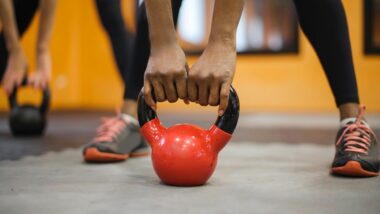Kettlebell squats offer numerous benefits for overall fitness and athleticism, targeting lower body muscle groups and improving strength, endurance, and posture. This exercise enhances lower body development and increases calorie burn during workouts. Regular practice can lead to improved muscle strength and endurance. By incorporating kettlebell squats into a workout routine, individuals can experience significant gains in overall fitness. Further exploration of proper technique and workout strategies can help reveal the full potential of this effective exercise, leading to a more thorough understanding of its advantages and applications.
Key Takeaways
- Kettlebell squats improve muscle strength and endurance.
- They enhance lower body development and posture.
- Kettlebell squats increase calorie burn during workouts.
- They engage multiple muscle groups for effective training.
- Kettlebell squats support overall fitness and athleticism.
Kettlebell Squat Benefits Explained
The implementation of kettlebell squats in a workout routine can have a profound impact on overall fitness, as this exercise offers numerous benefits. Kettlebell squats are a form of strength training that targets the lower body, making them an essential component of a full-body workout.
As a Kettlebell Exercise, squats engage multiple muscle groups, which helps to improve overall muscle strength and endurance. The movement also strengthens the lower back, which is essential for maintaining good posture and preventing injuries.
By incorporating kettlebell squats into a workout routine, individuals can experience significant improvements in their overall fitness and athleticism. This exercise is particularly beneficial for those seeking to enhance their lower body strength and endurance.
As part of a thorough fitness program, kettlebell squats can help individuals achieve their goals and feel a sense of belonging to a community that values strength and wellness. Regular practice of kettlebell squats can lead to noticeable improvements in overall physical fitness.
Incorporating kettlebell squats into a routine can also improve cardiovascular health and increase overall calorie burn during a workout, making it an excellent addition to a 20-minute kettlebell workout.
Muscle Groups Engaged
Kettlebell squats engage a multitude of muscle groups, making this exercise a highly effective way to build strength and endurance in the lower body.
This movement targets the entire posterior chain, including the muscles in the back, glutes, and legs. By incorporating kettlebell squats into your workout routine, you can improve your overall body strength and enhance your lower body development.
Some of the primary muscle groups engaged during a kettlebell squat include:
- Lower back muscles: which play a vital role in stabilizing the body
- Upper back muscles: that help maintain proper posture
- Glutes: responsible for extending the hip joint
- Leg muscles: such as the quadriceps, hamstrings, and calves, which work together to control the movement.
The kettlebell squat is a compound exercise that works multiple muscle groups simultaneously, making it an excellent choice for those seeking to improve their overall lower body strength and development.
Regular practice of kettlebell squats can lead to significant improvements in posture, balance, and overall athletic performance.
Incorporating kettlebell squats into a fitness routine can also promote kettlebell training, which is a versatile and effective way to improve overall fitness and build strength.
Proper Exercise Technique
When executing kettlebell squats, maintaining proper exercise technique is essential to guarantee a safe and effective workout. To achieve this, hold the kettlebell at chest height with elbows close to the ribcage and a tall posture, distributing weight evenly to create a stable position. Initiating the movement by pushing hips back and bending knees, while keeping the back straight and the kettlebell at chest height, is critical for a safe and effective kettlebell squat.
Proper form is essential, and this involves keeping the kettlebell close to the body and the weight in the heels as you lower into a squat position. Feet should be shoulder-width apart, allowing for balance and power generation throughout the movement. As you push through the heels to return to the starting position, squeeze the glutes and quadriceps to complete the exercise with proper form and technique. By focusing on proper exercise technique, you can perform a kettlebell squat that targets the front of the body, promoting a strong and stable physique through this effective exercise. Incorporating kettlebell squats into your routine can also improve your overall muscle strength, leading to a more efficient and effective workout.
Workout Plan Strategies
Crafting a well-structured workout plan is crucial for maximizing the benefits of kettlebell squats. A thorough exercise program should include proper form and technique, such as standing with feet shoulder-width apart and keeping your back straight, to guarantee a full range of motion.
To work harder and challenge yourself, consider incorporating different squat variations into your routine.
- Start with basics: Master the traditional Kettlebell Squat before progressing to more complex variations.
- Incorporate sumo squats: Widen your stance to target different muscle groups and increase flexibility.
- Add pulse squats: Increase time under tension to build strength and endurance.
- Combine with other exercises: Pair kettlebell squats with other exercises like Romanian deadlifts to create a well-rounded workout plan.
Regular kettlebell workouts, including those with cardiovascular endurance, can help improve overall fitness and increase strength.
Avoiding Common Injuries
Effective execution of a workout plan is closely tied to minimizing the risk of injury, and this is particularly relevant for kettlebell squats. To avoid common injuries, it is essential to maintain proper form and technique, including keeping the back straight and engaging the core.
Unlike barbell squats, kettlebell squats allow for more flexibility and can be modified to accommodate individual needs. For example, Goblet Squats can help stabilize the body and reduce the risk of injury. To perform kettlebell squats safely, it is vital to start with lighter weights and gradually increase the load, especially when holding a kettlebell.
This is particularly important for back squats and front squats, which can put additional strain on the joints. By incorporating proper technique and listening to the body, individuals can minimize the risk of injury and get the most out of their kettlebell squat workout, ultimately achieving a sense of belonging and community with fellow fitness enthusiasts. Incorporating a HIIT workout into a fitness routine can also enhance the benefits of kettlebell squats and support overall fitness goals.
Frequently Asked Questions
Are Squats With a Kettlebell Effective?
Proper form and muscle engagement enable increased strength, utilizing full range, as a compound exercise with ideal weight distribution, enhancing athletic performance.
Can You Do Kettlebell Squats Everyday?
Doing kettlebell squats daily sparks overtraining symptoms, jeopardizing muscle recovery, joint health, and increasing injury risk, making consistent training and balanced exercise frequency essential for a safe daily routine.
Will Kettlebell Squats Grow Glutes?
Proper squat technique in weight training enhances glute development, promoting significant muscle growth, and when incorporated into a consistent exercise routine, supports strength building, helping achievers reach their fitness goals.
Do Kettlebell Squats Burn Belly Fat?
Incorporating weight training into a fitness routine, such as kettlebell exercises, can enhance fat loss and belly reduction, while also improving core strength and overall muscle toning, yielding numerous exercise benefits.
Conclusion
Kettlebell squats offer numerous benefits. Approximately 70% of athletes report improved strength and flexibility. This statistic underscores the exercise's effectiveness in enhancing overall physical fitness, highlighting the importance of incorporating kettlebell squats into a workout routine for ideal results. Regular practice can lead to significant improvements in muscular endurance and athletic performance.


